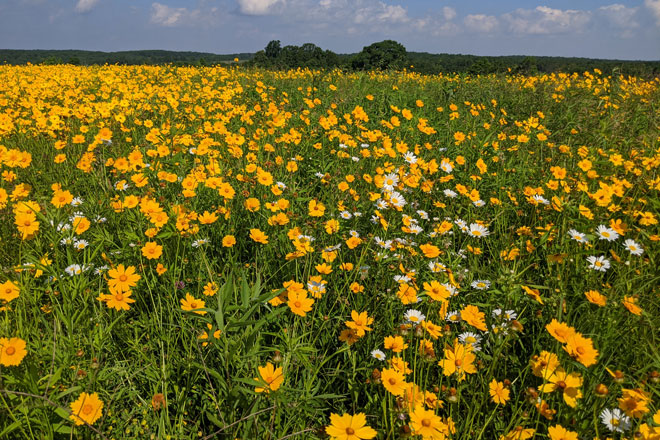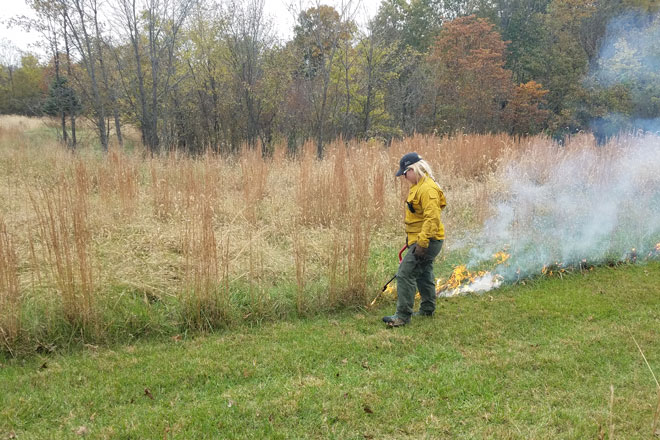Improving Quail Habitat with Prescribed Fire in the Fall
By William Robinson, Missouri Farm Bill Wildlife Biologist III and Chad Doolen, Missouri Farm Bill Wildlife Biologist II
Much of North America’s landscape has a historical relationship with fire, one that predates modern times and even European settlement of the continent. Fires played a role in shaping plant communities and wildlife habitat from one ocean to the other. Fires kept prairies relatively free of woody species and allowed wildflowers and grasses to thrive in woodlands. Over hundreds and thousands of years, plants and animals adapted to fire regimes where fires during the fall season were common occurrences (a site would have burned every 3 to 6 years on average). Seasonality and typically mild burn intensities fostered widespread and highly diverse plant and wildlife communities.
As Europeans settled North America, the presence of fire on the landscape began to change. Widespread fire suppression became common practice in the 1900s. Where fire remained on the landscape, it was no longer closely associated with fall. As a result, plant communities and habitat changed. On wooded landscapes, canopies and midstories began to close, which prevented light from reaching the ground layer and significantly reduced the presence of herbaceous vegetation. Woody vegetation expanded across what remained of the once vast prairies. As plant communities changed composition, so did their use by wildlife. Some wildlife would benefit from these changes, and other populations suffered.
 Bobwhite quail rely on a diverse mix of native grasses and wildflowers for nesting cover and brood rearing habitat.
Bobwhite quail rely on a diverse mix of native grasses and wildflowers for nesting cover and brood rearing habitat.
One population that suffers from a lack of fire is the northern bobwhite. Bobwhite quail rely on a diverse mix of native grasses and wildflowers for nesting cover and brood rearing habitat. Plant diversity attracts a wide array of pollinators and invertebrates in the spring and summer months, which provide protein for growing quail chicks. The wildflowers also produce seeds that can be consumed later in the season. For example, rough-leaved sunflower, and many other native sunflower species, responds well to fire-managed areas and sets fruit late in the summer and early autumn.
Prescribed fire can be used year-round to achieve different management objectives, however, fall burns can be especially effective for managing diverse, quail-beneficial habitat. Fall burns reduce woody encroachment, knock back cool-season grasses, and encourage native plant growth. In October and November, cool-season, sod-forming grasses like tall fescue and smooth brome are actively growing. Burning in the fall while woody species and undesirable cool-season grasses are growing will negatively impact those plants, and most will not recover before the first frost. Reducing the foothold of these undesirable species opens opportunities for native grasses and wildflowers to fill in during spring and summer. Prescribed fire in the fall allows native plants to thrive on a site, encouraging the species diversity and structural composition that benefits quail and many other wildlife!
 Fall burns reduce woody encroachment, knock back cool-season grasses, and encourage native plant growth.
Fall burns reduce woody encroachment, knock back cool-season grasses, and encourage native plant growth.
Prescribed burning is an efficient and effective management tool. With knowledge of fire behavior and burn plans, we can use prescribe burning as a tool to manage farms, manipulate wildlife habitat, and restore natural communities. Prescribed burning is so effective that government agencies and non-governmental organizations, including Pheasants Forever and Quail Forever, have staff dedicated to understanding the impacts of prescribed fire and expanding access and use.
After deciding to use fire as a tool, a manager needs to align their plan with their overall goals and objectives. Some goals will be short term, while others will be achieved over years. Natural community restoration and some habitat projects require long-term commitments. Fall burning lends itself well to this scenario. However, a manager needs to commit to a fire regime (conducting burns every 2 to 6 years, mostly occurring at the same time of year, and rarely incorporating burning in other seasons to address specific needs) rather than viewing each burn as a one-off event (in other words, the effects will build over time).
.jpg.aspx) Using prescribed fire in the fall can be an excellent tool to mitigate these risks and begin the journey of restoring habitat for quail and other native grassland species
Using prescribed fire in the fall can be an excellent tool to mitigate these risks and begin the journey of restoring habitat for quail and other native grassland species
Bobwhite quail require specific habitat to thrive. Throughout history, we have watched much of that habitat disappear. Woody encroachment and introduced plants are two of the biggest threats to their habitat. Using prescribed fire in the fall can be an excellent tool to mitigate these risks and begin the journey of restoring habitat for quail and other native grassland species. Not sure if prescribed fire is right for you? Reach out to your local Pheasants Forever or Quail Forever biologist or other natural resource professional for further guidance.
Much of the information here is presented from a perspective of managing resources in Missouri. Details mentioned may be similar for other parts of the country or need modification to best match conditions and accomplish habitat goals elsewhere. Still, Missouri is a diverse state with prairies, woodlands, forests, and swamps. Information and studies that apply to Missouri’s landscapes may be applicable to other regions in the country. Here are some resources that can help you learn more about prescribed fire and burning in your area: